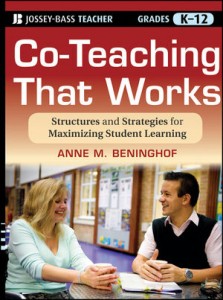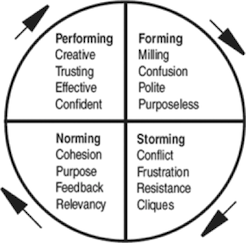How to Make Co-Teaching Work
A MiddleWeb Blog
Co-teaching that works. Doesn’t that sound like something you’d sign up for in a minute? It is a positive statement that leaves no room for the possibility of co-teaching not working. I love it.
That was the title of a professional development conference I attended recently. Presented by Anne Beninghof, the conference was a perfect match with its title. Anne’s greeting was welcoming, and her entire day-long presentation was engaging and inspiring. The day flew by.
All of the information shared at the conference was in alignment with Anne’s book, Co-Teaching That Works: Structures and Strategies for Maximizing Student Learning. I’ve found the book to be a great resource for all co-teachers and administrators. It includes so many options that help open-minded educators to find solutions as they strive to create positive inclusion programs. (Read this MiddleWeb review by special educator Cossondra George to learn more details about the book.)
It makes sense for all involved in co-taught classrooms to have a clear understanding about what co-teaching actually is. Anne makes this point:
Effective co-teaching can be compared to synchronized swimming—teammates must carefully coordinate, not only to win but to avoid drowning.
Throughout the seminar, Anne sent a clear message that co-teachers must never just show up and say, “Hey, what are we doing today?”
After framing these essentials, Anne spent the rest of the day with us discussing viable solutions to so many of the common co-teaching woes. Let’s begin at the beginning.
Setting a firm foundation
Each co-teacher must enter the job assignment with a team mindset. Anne suggests having co-teachers complete a co-teaching assessment to bring forth personal feelings and beliefs in order to jump start productive communication. She suggested the Colorado Assessment of Co-Teaching (Co-ACT). Not only is this a good place to begin effective communications between co-teachers, it can be an eye-opener during the process of exploring one’s own personal views. Let’s face it; we can’t begin to communicate effectively with others until we are clear about our own feelings and opinions.
Anne shared a few of the common mistakes of co-teaching. Here are some examples:
- “Parking Lot or Hallway Planning”: When teachers fail to have a regularly scheduled co-planning meeting time.
- “Tightening the Corset”: When one or both teachers demonstrate a lack of flexibility
- “Too Many Cooks Syndrome”: When there is role confusion, the teachers create a disorganized and ineffective learning environment.
Co-teaching: Problems and solutions

In addition, the success of the co-teaching relationship and student learning depends on good communication. Anne emphasized that teachers “should not be a victim of assumicide.” When we assume something will happen (rather than plan for it), it is very likely that communication will fall flat and an awkward learning environment will be the result.
Anne continued in her solution sharing mode by providing some ideas teachers can pursue to find the time to co-plan. Here are a few:
- Use a sustained silent reading time to find some time to plan together.
- “Roaming Sub” where teachers sign up on a rotating basis for a building sub to cover their planning time.
- Notice the substitutes in the building. These subs may use their prep time to cover your time to co-plan.
Creating a Positive Team Approach

As a tool to guide teachers’ comfort levels in speaking out loud and proud, Anne suggested this Team Development Wheel, which was adapted from the well-known group development work of Bruce W. Tuckman. This wheel is a good organizer to show teachers where they are along the cohesive team continuum.
The goal is to spend the majority of time in stage 4: performing. But before teams get there they must go through steps 1 through 3, which includes being extremely polite (forming – stage 1), beginning to be honest and share differences (storming – stage 2), and developing rules to be able to work through the differences (norming – stage 3). Teachers who work to avoid discomfort remain in stage 1 and 2. Now there’s something to think about. And if you want to read more about team development, also check this out.
A provocative question
One of the final activities during this day of rich professional growth opportunities was a sentence completion discussion starter:
The marriage between special education and general education is like…
Some responses expressed at the conference included: fine wine — sweet and sour sauce — crunchy peanut butter — an ocean. The most surprising (and blunt) analogy? “A one legged man in a butt kicking contest.” That one sounds headed for divorce!
How would you describe the general/special education marriage?
Watch for my interview with Anne Beninghof which we’ll post here on Feb. 25!

































Elizabeth,
How lucky you are to hear Anne present and such rich nuggets she shared! Co-teaching is indeed like a marriage, an arranged one often times. My favorite response above was the fine wine reference. I like to think that our relationships with our teaching partners develops over time into a seamless one in which we anticipate one another’s thoughts and ideas. When this happens it can be so magical for the kids and us.
Anne’s comments about our ethical responsibility to speaking out loud and proud for our students reminded me of times in the past when I had to. It saddens me deeply when teachers forget that although their students may be younger than they are, they have the right to be treated fairly and with respect. Although it can make things very stressful and uncomfortable, it is indeed our ethical and professional responsibility to speak up for our them.
Thank-you for sharing these excellent resources, Elizabeth.
Thank you for the additional resources. They will come in handy as we move forward with team development. Thanks for sharing Anne’s information.
Our elementary school is investigating and training our teachers in co-teaching planning. I would love to have favorite resources and any excellent suggestions for co-teaching workshops or conferences on subject for this summer of 2015.
Would appreciate any ideas.